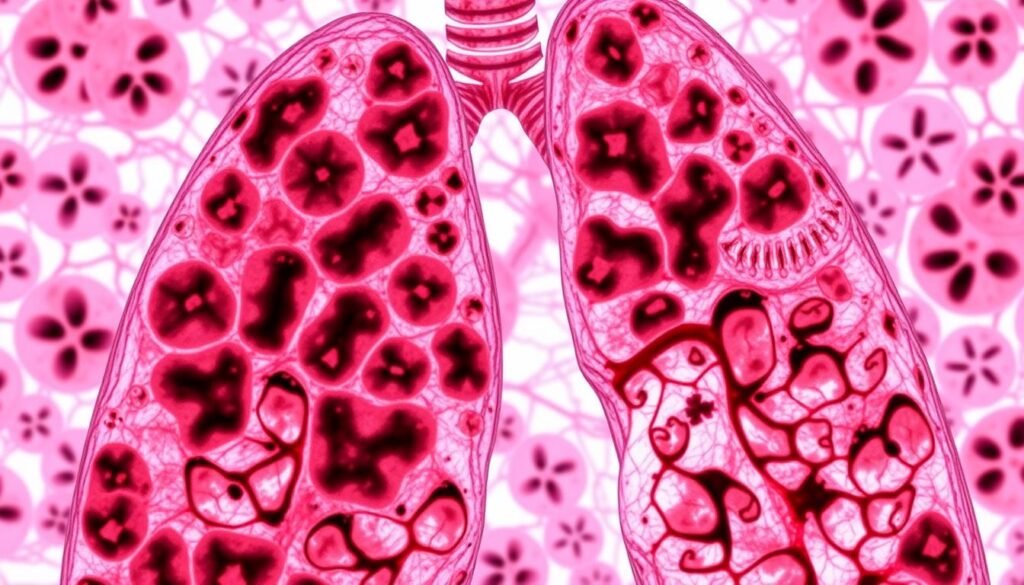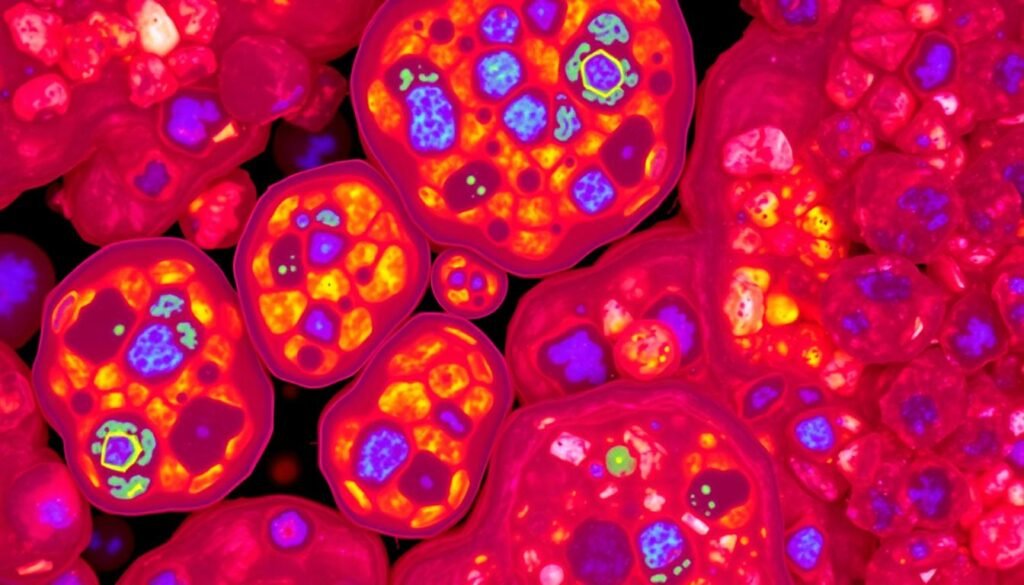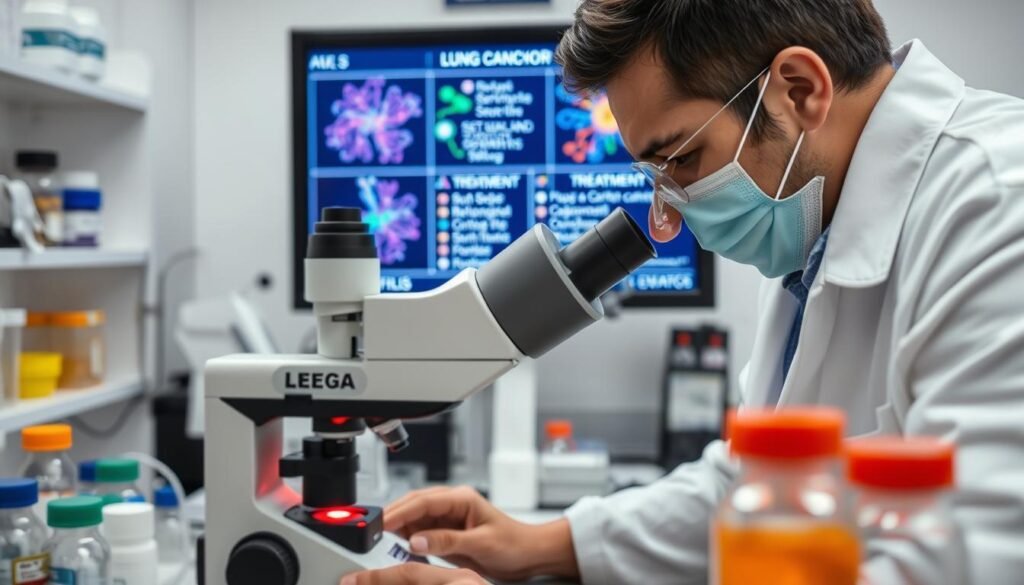Did you know that non-small cell lung cancer (NSCLC) is the most common lung cancer? It makes up about 80% to 85% of all cases. This huge number shows why knowing the different lung cancer subtypes is crucial. It affects how a patient is diagnosed and treated. In this article, you’ll learn about the various lung cancer types, their characteristics, risk factors, and how they’re treated.
Let’s dive into the specifics. For instance, adenocarcinoma is the most common subtype. On the other hand, small cell lung cancer (SCLC) is known for being aggressive. By understanding these subtypes, we can find lung cancer earlier. This also helps in talking about it with doctors. This guide is for patients, caregivers, or anyone wanting to know more about lung cancer.
Key Takeaways
- NSCLC accounts for 80% to 85% of lung cancer cases.
- Adenocarcinoma is the most common subtype and can affect smokers and non-smokers alike.
- Squamous cell carcinoma is often linked to smoking and found in the central lung area.
- Large cell carcinoma is fast-growing and can spread quickly throughout the lungs.
- SCLC makes up 10% to 15% of lung cancer cases, typically spreading faster than NSCLC.
- Lung carcinoid tumors represent fewer than 5% of lung tumors and grow slowly.
- Understanding lung cancer subtypes is essential for informed treatment decisions.
Understanding Lung Cancer
Lung cancer is a major health issue in the United States. About 235,000 new cases are diagnosed every year. The disease starts in the lungs. These organs manage the exchange of oxygen and carbon dioxide. There are mainly two kinds of lung cancer: non-small cell lung cancer (NSCLC) and small cell lung cancer (SCLC). NSCLC makes up 80-85% of all cases. SCLC is less common, making up 10-15% of diagnoses.
Smoking is a big risk factor for lung cancer. It’s linked to almost 90% of all cases. Interestingly, 60% of people who get diagnosed used to smoke but have since quit. This shows how past smoking can affect your health. Even secondhand smoke is dangerous. It causes thousands of lung cancer cases every year. Most people who get lung cancer are 65 or older when they’re diagnosed.
Finding lung cancer early is hard but important. If caught early, more than 90% of patients survive. Knowing symptoms like chest pain and a lasting cough is key. Lung cancer can be of various types, like:
- Adenocarcinoma
- Squamous cell carcinoma
- Large cell carcinoma
- Small cell lung cancer
- Lung carcinoid tumors
Understanding the lungs’ structure and how they work helps us know how cancer grows. Lung cancer’s stage shows how far it has spread. This affects treatment choices.
| Cancer Type | Percentage of Cases | Key Characteristics |
|---|---|---|
| Non-Small Cell Lung Cancer | 80-85% | Usually grows slower. Includes adenocarcinoma, squamous cell, and large cell carcinoma. |
| Small Cell Lung Cancer | 10-15% | Faster spreading and very aggressive. Smoking is a major cause. |
| Lung Carcinoid Tumors | 1-2% | Not as common, varying in how quickly they grow. |
With a good lung cancer understanding, people can better handle the disease. This includes knowing about diagnosis, treatment, and managing the condition.
Types of Lung Cancer
Lung cancer is mainly split into two types: non-small cell lung cancer (NSCLC) and small cell lung cancer (SCLC). Each type has unique traits and treatments. Knowing the difference is key for proper care.
NSCLC makes up about 80% to 85% of lung cancer cases and has several subtypes. Adenocarcinoma is the most common, especially in those who’ve never smoked. Squamous cell carcinoma and large cell carcinoma are also major subtypes.
About 15% to 20% of lung cancers are SCLC. It’s linked to smoking and grows quickly. Treatment usually involves chemotherapy and radiation therapy.
Knowing the difference between NSCLC and SCLC helps tailor treatment plans. For a deep dive into lung cancer types, visit here.
| Type of Lung Cancer | Percentage of Cases | Common Subtypes | Key Features |
|---|---|---|---|
| Non-Small Cell Lung Cancer (NSCLC) | 80% – 85% | Adenocarcinoma, Squamous Cell Carcinoma, Large Cell Carcinoma | Various treatment options including surgery, radiation, and chemotherapy |
| Small Cell Lung Cancer (SCLC) | 15% – 20% | N/A | Rapid growth and spread; primarily treated with chemotherapy |
Non-Small Cell Lung Cancer
Non-small cell lung cancer (NSCLC) is found in about 85% of lung cancer cases in the U.S. It includes types like adenocarcinoma, squamous cell carcinoma, and large cell carcinoma. These subtypes have unique features. Knowing about these helps in creating specific treatments, important for patients and doctors.
About 234,580 people might get lung cancer in the U.S. in 2024. Around 125,070 could die from it, showing the need for better screening and treatment. Low-dose helical CT scans help catch lung cancer early. This is key for finding non-small cell lung cancer soon.
Doctors use imaging and biopsies to confirm NSCLC. Symptoms like a constant cough, chest pain, and losing weight without trying could mean NSCLC. Smoking, being around secondhand smoke, and pollution increase the risk. For smokers, the risk is much higher than for nonsmokers.
NSCLC treatments include surgery, chemotherapy, and targeted therapies. These therapies are based on the cancer’s specific mutations. Survival rates change a lot based on when the cancer is found. If found early, 63% of people might live five more years. This drops to 8% if it’s found late.
NSCLC subtypes grow and respond to treatments differently. So, talking about personalized treatments is becoming more common. Patients can look into treatments for their cancer’s specific mutations with biomarker testing. This testing helps doctors find the best targeted treatments.
Adenocarcinoma: The Most Common Subtype
Adenocarcinoma is the leading type of lung cancer, making up nearly 40% of cases. It mainly starts from the mucus-producing cells in the lungs. Often, it’s found in the lungs’ outer areas. It’s known for occurring in non-smokers, which makes it different from other lung cancers.
Characteristics of Adenocarcinoma
Adenocarcinoma shows different patterns like lepidic, papillary, acinar, micropapillary, and solid. The solid pattern is seen in 46% of patients. Meanwhile, acinar and papillary patterns are found in 26% and 17% of cases. Those with micronodular or solid patterns face worse survival rates than others.

Demographics and Risk Factors
In the last 40 years, adenocarcinoma cases in women have increased. Now, it’s more significant in cancer studies. People are usually diagnosed at age 71. Not all patients are smokers. Some non-smokers get it too. Changes in genes like EGFR and ALK can affect treatment, showing how complex this cancer type is.
Squamous Cell Carcinoma
Squamous cell carcinoma is a major type of lung cancer. It usually starts in the lung’s central areas, close to the airways. Knowing its unique features and risk factors helps in dealing with it better.
Link to Smoking and Location
Smoking is a big factor in squamous cell carcinoma. Most people who get it have smoked before. This shows how vital quitting smoking is to prevent lung cancer. This cancer mostly begins in the bronchi. It tends to grow slower than other lung cancers.
It’s more common in men than in women. This fact highlights the tie to smoking habits, which are more usual among men. Realizing how smoking leads to this cancer helps health experts create better prevention and cure plans.
Large Cell Carcinoma
Large cell carcinoma is a type of non-small cell lung cancer. It has unique diagnosis and treatment challenges. This cancer subtype has large, abnormal cells and can start in any part of the lung. It grows quickly, making it spread faster than other lung cancer types.
Growth and Spread of Large Cell Carcinoma
Large cell carcinoma grows fast, affecting patient survival. Quick diagnosis is crucial for effective treatment. Often, its symptoms don’t directly point to lung cancer. This fact highlights the need to know the early signs of this cancer.
Many patients with this cancer are diagnosed at late stages, like III or IV. Treatment usually combines surgery and chemotherapy. This approach offers better results than surgery alone. Patients and doctors must understand this cancer’s aggressive spread to manage it effectively.

| Characteristics | Details |
|---|---|
| Histology | Undifferentiated non-small cell carcinoma |
| Growth Rate | Rapid |
| Common Locations | Upper lobe of the lung |
| Stage at Diagnosis | Often stage III or IV |
| Patient Demographics | Majority over 60 years, more prevalent in males |
| Prognosis | Improves with combination of surgery and chemotherapy |
Knowing about large cell carcinoma’s growth and spread helps in making treatment choices. Continuous research and increased awareness are key. They improve early detection and treatment of this aggressive lung cancer type.
Small Cell Lung Cancer
Small cell lung cancer (SCLC) makes up about 13%-15% of all lung cancer cases. It is known for its aggressive behavior. This type mostly occurs in heavy smokers and often spreads beyond the chest by the time it’s found.
Survival rates for SCLC are grim, with less than 7% of patients living beyond five years. This highlights how deadly this cancer can be compared to other cancers.
SCLC has a high rate of genetic mutations that drive its growth and spread. There are two main kinds: small cell carcinoma and the mixed type with large cells. Each type is further divided by certain gene markers and how the cancer behaves.
The primary treatment for SCLC is chemotherapy, especially with drugs like cisplatin and etoposide. Using these drugs together improves survival more than using one drug alone. Initially, SCLC usually reacts well to treatment, but most patients see their cancer return. After a year, only about 12.6% don’t have their cancer grow back when treated with newer medicines that help the immune system.
Newer treatments, including drugs called immune checkpoint inhibitors, are providing hope. Drugs such as atezolizumab, pembrolizumab, and nivolumab are being used more often. Scientists have found four unique genetic types of SCLC. This could lead to treatments tailored to each patient, possibly improving how well they do.
Lung Cancer Subtypes and Their Impact on Treatment
Lung cancer treatment varies, as each subtype needs its own approach. It’s key to know how to treat non-small cell lung cancer (NSCLC) and small cell lung cancer (SCLC). This knowledge helps doctors give the best care possible.
Treatment Options for NSCLC
NSCLC’s treatment can include surgery, chemo, radiation, and targeted therapy. The choice of treatment depends on the cancer’s stage, its subtype, and any genetic markers. Let’s look at the common treatments:
- Surgery: This is usually for certain adenocarcinoma or squamous cell carcinoma. It can help patients live longer.
- Chemotherapy: This therapy helps shrink tumors and ease symptoms. It is a mainstay of NSCLC treatment.
- Targeted Therapy: If patients have certain genetic changes, targeted drugs can attack these unique cancer features.
- Radiation Therapy: This can be used alone or with other treatments, especially for those who can’t have surgery.
Treatment Options for SCLC
SCLC treatment is more aggressive due to its quick spread. The focus is primarily on chemo and radiation:
- Chemotherapy: A platinum-based chemo is the go-to treatment for SCLC. It aims to shrink the tumor and slow the disease.
- Radiation Therapy: Used with chemo, radiation helps control the growth of the tumor in the area.
- Immunotherapy: Some patients might get immunotherapy. Although it’s not always effective, it can halt cancer growth in a few cases.
So, it’s clear that knowing the difference in treatment for NSCLC and SCLC is crucial. Customizing treatment can greatly improve outcomes and life expectancy for patients.
| Type of Lung Cancer | Treatment Options | Notable Characteristics |
|---|---|---|
| NSCLC | Surgery, Chemotherapy, Targeted Therapy, Radiation | Makes up 80%-85% of lung cancers; each subtype needs a different approach. |
| SCLC | Chemotherapy, Radiation, Immunotherapy | Represents about 10%-15% of lung cancers; usually found at a late stage. |

Other Types of Lung Tumors
Lung tumors are not just one type. They include rare ones like lung carcinoid tumors and mesothelioma. These rare types are important to know about. They add to our understanding of lung cancers. This knowledge helps in their treatment and understanding their effects.
Lung Carcinoid Tumors
Lung carcinoid tumors are rare, making up 1-6% of lung tumors. They grow slowly and start in the lungs’ neuroendocrine cells. Most are typical carcinoids, about 90% of them. People with these tumors often live more than five years after being diagnosed. Surgery is usually the best treatment if the tumor has not spread.
Mesothelioma and Its Relation to Lung Cancer
Mesothelioma is linked to asbestos exposure. It affects the lung’s lining and is very aggressive. People with this cancer live about 12 to 21 months after diagnosis. It’s mostly seen in jobs with high asbestos exposure. Treating mesothelioma requires many approaches, like chemotherapy, radiation, and surgery. This shows how serious and complex this cancer is.
| Type of Tumor | Prevalence | Prognosis | Treatment Options |
|---|---|---|---|
| Lung Carcinoid Tumors | 1-6% of lung tumors | Average survival: 5+ years | Surgery, possible chemotherapy |
| Mesothelioma | Rare, linked to asbestos exposure | Average survival: 12-21 months | Chemotherapy, radiation, surgery |
Identifying Lung Cancer Symptoms
Lung cancer symptoms often appear softly and are missed by many. Knowing these symptoms is vital because early detection helps treatment. The most common symptoms are:
- Coughing, especially a cough that gets worse or doesn’t go away.
- Chest pain that gets sharper with a deep breath, cough, or laughter.
- Shortness of breath happening during simple activities or while resting.
- Unintended weight loss, suggesting other health problems might be present.
- Fatigue and feeling sick more overall.
- Coughing up blood, a sign that you need to see a doctor right away.
Getting to know these lung cancer symptoms can help you seek help sooner. A large study found that only 0.2% of people with a three-week cough had lung cancer. This shows how hard it can be to spot these early signs.
In the UK, the wait time for lung cancer patients to get referred was around 14 days. Some waited up to 90 days. Many had seen their doctors several times before finding out they had cancer. A third of lung cancer cases are caught in emergency situations. This means we must be more careful in watching for these symptoms.
Genes and how we live can affect lung cancer risks. Smoking is the biggest risk, causing over 70% of lung cancer deaths. Work hazards and pollution are also risks. More men get lung cancer due to past smoking rates.
If you have these symptoms, getting checked early is key. It can make a big difference in treatment and survival. For more info on lung cancer, check out this detailed article.
| Symptom | Frequency | Severity Level |
|---|---|---|
| Cough | Common | Persistent |
| Chest Pain | Less Common | Moderate to Severe |
| Shortness of Breath | Common | Variable |
| Weight Loss | Common | Significant |
| Coughing up Blood | Rare | Severe |
Conclusion
Understanding lung cancer is vital. It helps in managing and treating this serious disease. Each type, like adenocarcinoma and small cell lung cancer, has its own challenges.
Early detection can lead to better outcomes. This shows why it’s key to notice early symptoms and get medical advice quickly. Never ignore signs like a persistent cough or chest pain.
Lung cancer causes many cancer-related deaths. Knowing the risks, like smoking and genetics, can help in early diagnosis. This awareness encourages discussions with doctors about symptoms and risks.
Informed patients are likely to get screenings sooner. This increases their chances of successful treatment. It makes a big difference in fighting lung cancer.
About 60.5% of lung cancers are squamous cell carcinoma, and 39.5% are adenocarcinoma. These subtypes are different in how they grow and respond to treatments.
By learning about these types and talking with doctors, patients can better manage their condition. This knowledge not only helps them but also supports the fight against lung cancer in the U.S. For detailed information on early lung cancer signs, click here.